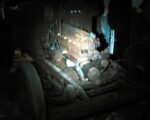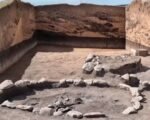In a remarkable archaeological discovery, a well-preserved statue of the Greek god Hermes has been found in an ancient Roman sewer in Bulgaria. The statue, standing nearly seven feet tall, was uncovered during excavations at the site of Heraclea Sintica, an ancient city near the village of Rupite. This find sheds new light on the historical significance of the area and the preservation of ancient artifacts.
The Discovery of the Hermes Statue
Archaeologists excavating the ancient city of Heraclea Sintica were astonished to find a nearly intact statue of Hermes in a Roman sewer. The statue, believed to date back to the 2nd century C.E., was buried under layers of dirt for over 1,650 years. This remarkable preservation is attributed to the careful burial of the statue, likely to protect it from earthquakes and the rise of Christianity, which led to the banning of pagan symbols.
The excavation team, led by Dr. Lyudmil Vagalinski, has been working on the site since 2007. The discovery of the Hermes statue is considered one of the most significant finds in the area. The statue’s only damage includes minor cracks on the left hand and a missing piece of the right arm. The detailed craftsmanship and the statue’s size suggest it was created by a master sculptor from a single block of marble.

The statue’s discovery in a sewer system highlights the lengths to which ancient inhabitants went to preserve their cultural heritage. The sewer, known as “Cloaca Maxima,” served as a protective burial site for the statue, ensuring its survival through centuries of historical upheaval.
Historical Significance of Heraclea Sintica
Heraclea Sintica, founded by King Philip II of Macedon, has a rich history dating back to between 356 and 339 B.C.E. The city was rediscovered in 2002, and since then, numerous archaeological excavations have revealed its historical importance. The discovery of the Hermes statue adds to the city’s significance, providing insights into the cultural and religious practices of its ancient inhabitants.
The city’s strategic location near the Greek border made it a vital center for trade and cultural exchange. The presence of such a well-preserved statue indicates the city’s prosperity and the high level of craftsmanship achieved by its artisans. The statue is believed to be a Roman copy of a Greek original, reflecting the influence of Greek culture on Roman art.
The excavation of Heraclea Sintica has uncovered various artifacts, including pottery, coins, and architectural remains. These findings contribute to our understanding of the city’s daily life, economy, and religious practices. The Hermes statue, in particular, offers a glimpse into the religious beliefs and artistic achievements of the ancient city.
Future Plans for the Hermes Statue
Following its discovery, the Hermes statue will undergo careful restoration before being displayed at the Petrich Historical Museum. The museum plans to highlight the statue as a centerpiece of its collection, showcasing the rich cultural heritage of Heraclea Sintica. The restoration process will involve cleaning the statue, repairing any damage, and ensuring its long-term preservation.
The discovery of the Hermes statue has generated significant interest among archaeologists and historians. Researchers hope to uncover more artifacts in the area, further illuminating the history of Heraclea Sintica. The excavation team plans to continue their work, focusing on other parts of the ancient city that may hold additional treasures.
The statue’s display at the Petrich Historical Museum will provide an opportunity for the public to appreciate the artistry and historical significance of this remarkable find. It will also serve as a reminder of the importance of preserving cultural heritage and the ongoing efforts of archaeologists to uncover the past.













